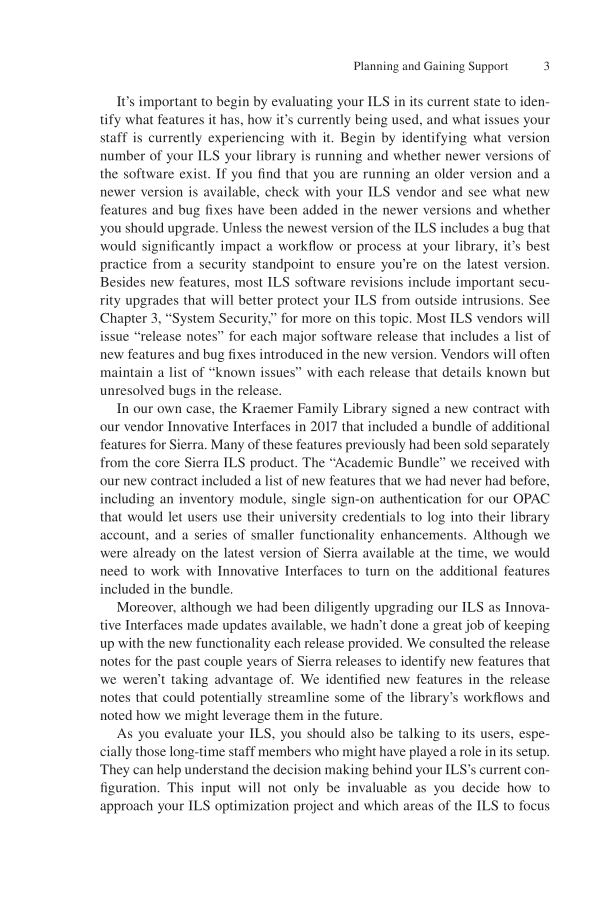Planning and Gaining Support 3 It’s important to begin by evaluating your ILS in its current state to iden- tify what features it has, how it’s currently being used, and what issues your staff is currently experiencing with it. Begin by identifying what version number of your ILS your library is running and whether newer versions of the software exist. If you find that you are running an older version and a newer version is available, check with your ILS vendor and see what new features and bug fixes have been added in the newer versions and whether you should upgrade. Unless the newest version of the ILS includes a bug that would significantly impact a workflow or process at your library, it’s best practice from a security standpoint to ensure you’re on the latest version. Besides new features, most ILS software revisions include important secu- rity upgrades that will better protect your ILS from outside intrusions. See Chapter 3, “System Security,” for more on this topic. Most ILS vendors will issue “release notes” for each major software release that includes a list of new features and bug fixes introduced in the new version. Vendors will often maintain a list of “known issues” with each release that details known but unresolved bugs in the release. In our own case, the Kraemer Family Library signed a new contract with our vendor Innovative Interfaces in 2017 that included a bundle of additional features for Sierra. Many of these features previously had been sold separately from the core Sierra ILS product. The “Academic Bundle” we received with our new contract included a list of new features that we had never had before, including an inventory module, single sign-on authentication for our OPAC that would let users use their university credentials to log into their library account, and a series of smaller functionality enhancements. Although we were already on the latest version of Sierra available at the time, we would need to work with Innovative Interfaces to turn on the additional features included in the bundle. Moreover, although we had been diligently upgrading our ILS as Innova- tive Interfaces made updates available, we hadn’t done a great job of keeping up with the new functionality each release provided. We consulted the release notes for the past couple years of Sierra releases to identify new features that we weren’t taking advantage of. We identified new features in the release notes that could potentially streamline some of the library’s workflows and noted how we might leverage them in the future. As you evaluate your ILS, you should also be talking to its users, espe- cially those long-time staff members who might have played a role in its setup. They can help understand the decision making behind your ILS’s current con- figuration. This input will not only be invaluable as you decide how to approach your ILS optimization project and which areas of the ILS to focus
Document Details My Account Print multiple pages
Print
You have printed 0 times in the last 24 hours.
Your print count will reset on at .
You may print 0 more time(s) before then.
You may print a maximum of 0 pages at a time.





































































































































































